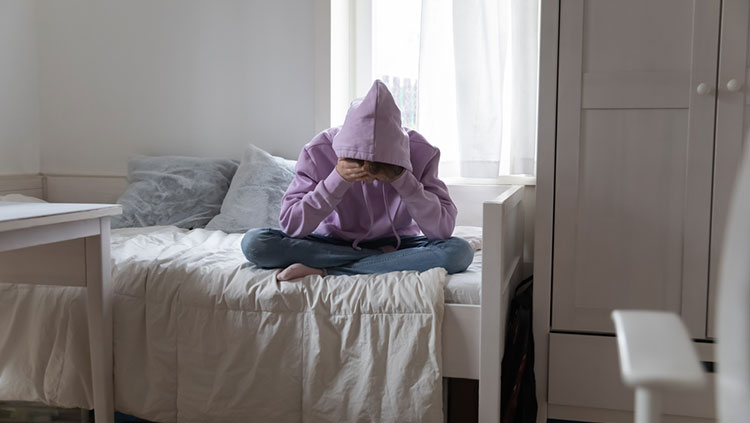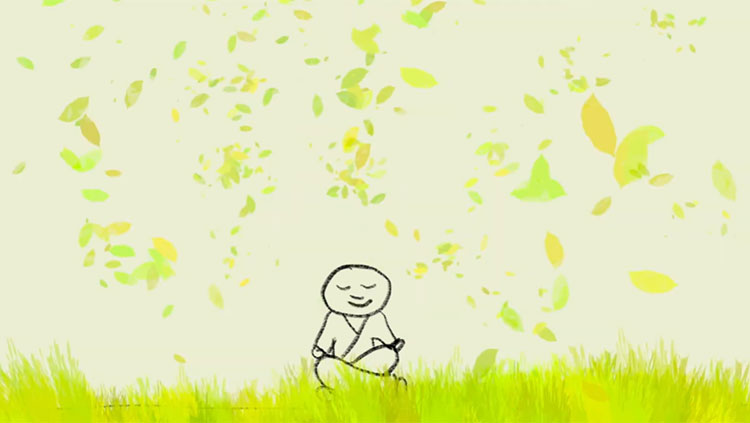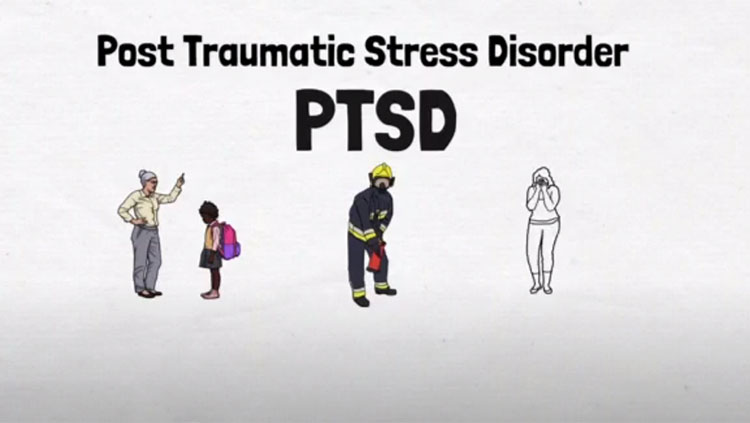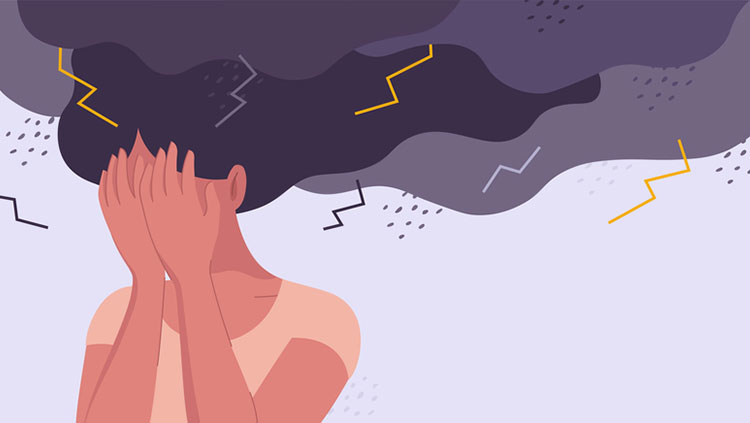Feeling Scared and Anxious During the COVID-19 Pandemic Is Normal. Here’s Why.
- Published14 May 2020
- Author Alexis Wnuk
- Source BrainFacts/SfN
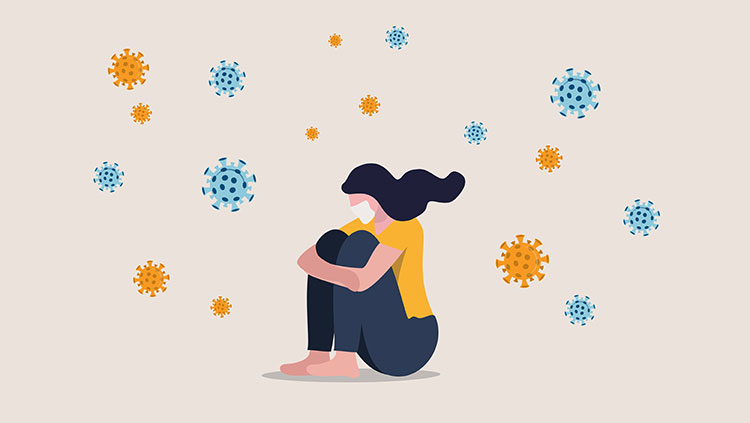
I wasn’t afraid until I went to the grocery store. The shelves, which normally held every conceivable variety of rice, quinoa, and beans, were bare. I scanned my shopping list and noted which items I’d have to go without, which meals I could no longer make. All the while, a small voice in the back of my mind grew louder. What if I run out food? What if there’s nothing to eat? Is this just what life is like now?
As news of the COVID-19 pandemic intensified, these worrying thoughts persisted like an invisible vise tightening around my stomach. With each headline, my heart beat faster and every muscle in my body tensed. Yet, all these feelings are normal.
The adrenaline that surged through my body when I read the news is part of a hardwired biological response designed to keep me safe. Fear triggers these automatic responses — a racing heart, quickening breath — to prepare our bodies to flee, fight, or freeze in the face of danger. The thing is, I wasn’t in any immediate danger quarantined at home.
A Novel Threat
“COVID-19 is unique,” says Roxane Cohen Silver, who studies how we cope with traumatic events. At an online press briefing on March 30, the UC Irvine psychologist described what differentiates the pandemic from other crises. “This is an invisible threat. We don’t know who is infected, and anybody could infect us,” she said. It’s also an ambiguous threat because “we have no idea how bad this will get.”
That ambiguity conflicts with our wiring and our innate need to understand and to plan. “Our brains hate not knowing things,” says Judson Brewer, a neuroscientist and psychiatrist at Brown University. “Our prefrontal cortices are set up to plan, and they need accurate information to plan. They also need precedent because we plan for future events based on past events.”
Located at the front of the brain, the prefrontal cortex is involved in high-level functions like planning, reasoning, and decision-making. Through its connections with other parts of the brain, it helps us focus our attention and regulate our emotions. But stress flips the switch on the prefrontal cortex; when it goes offline, the brain’s emotion and habit centers take over and our minds spin out over every possible “what if” scenario.
“It’s totally natural” to have some level of anxiety in new situations, says University of Michigan neuroscientist Jacek Debiec. Whereas fear equips you to deal with an immediate threat to your safety, anxiety is more “a state of preparation for perceived or expected threats,” he says. If you’re visiting a foreign country where you don’t know the language, for example, you may be more vigilant and concerned about your safety.
Out of Control
Fear motivates us to change our behavior and adapt to challenges. You stay home, wash your hands more frequently, and practice social distancing, all of which reduce your chances of catching the virus or passing it on to others.
In a recent study published on the preprint server PsyRxiv, scientists surveyed 1,591 American adults about the COVID-19 pandemic. They asked them what they thought their chances were of getting infected and whether they were engaging in recommended behaviors like frequent hand-washing and social distancing. Believing that they had a high likelihood of personally becoming infected was the strongest predictor of hand-washing and social distancing. Concern about passing the virus on to other people didn’t predict any changes in behavior. The message that seems to get through to people is “concern about one’s own safety, not about the safety of other people,” says Debiec, who was not involved in the study. “Being scared is good, in a way.”
But, outside of measures to keep ourselves safe, there’s little within our control. “We can’t take the coronavirus away,” says Rajita Sinha, director of the Yale Interdisciplinary Stress Center.
Sinha has identified three key features of stressful situations: they’re uncontrollable, unpredictable, and sustained. The coronavirus pandemic checks all those boxes. When all three of these features are present, it can overwhelm our ability to manage the stress, Sinha says.
Acknowledging our fear and “accepting that there’s not a whole lot one can do about the virus itself” is important, Sinha says. It frees up mental resources so we can consider other and more helpful ways of coping.
The 24/7 Trigger
Just as fear is an adaptive response that helps us survive, so too is fear contagion. We can’t possibly learn about all the dangers of the world firsthand, so we count on others to warn us — seeing someone who is afraid or panicked triggers fear in us, Debiec says.
The modern world amplifies this learned behavior, often to our detriment. “When we are exposed to images or threat signals 24/7, then all the time you have this perception of the immediate presence of threat,” Debiec says.
That triggers the fight-or-flight response, which is not particularly helpful in these situations — especially when you’re at home in your pajamas. “We cannot do much with this response, so we have to regulate how much of this information reaches us,” Debiec says.
Debiec and Brewer both recommend limiting news consumption. Exercise, adequate sleep, and mindfulness practices can also be helpful, Sinha says. The Yale Stress Center hosts a free weekly webinar about mindfulness exercises for coping with coronavirus anxiety, and Brewer created a free app with breathing exercises.
These coping strategies may not be enough for everyone. The chronic, uncontrollable stress of the pandemic can trigger underlying mental and physical health vulnerabilities, Sinha says, and lead to people feeling overwhelmed or helpless. In that case, it’s important to seek professional help from a mental health care provider.
“We have a very uncertain future. We don’t know how long this will last,” Silver said. “It is extremely important, however, that we acknowledge that this uncertainty is stressful. And, in fact, this anxiety is appropriate under the circumstances.”
CONTENT PROVIDED BY
BrainFacts/SfN
Discussion Questions
1) What automatic responses does fear trigger?
2) What role does fear play in survival?
3) Why does uncertainty cause stress?
References
Arnsten, A. F. T. (2009). Stress signaling pathways that impair prefrontal cortex structure and function. Nature Reviews. Neuroscience, 10(6), 410–422. doi: 10.1038/nrn2648
Kober, H., Buhle, J., Weber, J., Ochsner, K. N., & Wager, T. D. (2019). Let it be: Mindful acceptance down-regulates pain and negative emotion. Social Cognitive and Affective Neuroscience, 14(11), 1147–1158. doi: 10.1093/scan/nsz104
Wise, T., Zbozinek, T. D., Michelini, G., Hagan, C. C., & Mobbs, D. (2020). Changes in risk perception and protective behavior during the first week of the COVID-19 pandemic in the United States. PsyArXiv. doi: 10.31234/osf.io/dz428
Also In Mental Health
Trending
Popular articles on BrainFacts.org




